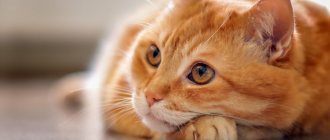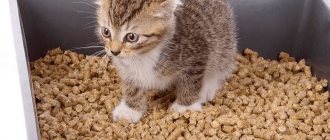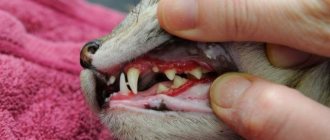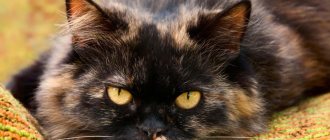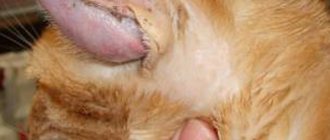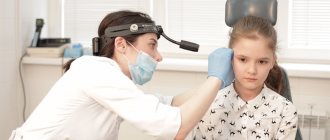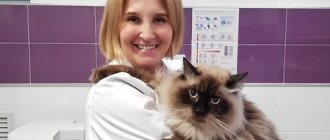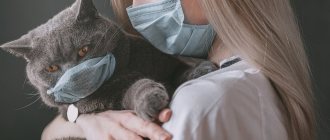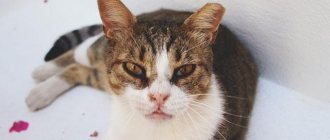Every person has suffered from nasal congestion at least once in their life and felt how unpleasant this condition can be. Fortunately, today there are a wide variety of products available on the market that can help alleviate the condition. However, few people think that pets also have to suffer from similar phenomena from time to time. The problem is that the pet will not be able to tell its owner about this. Below we tell you how to promptly notice that your cat has a stuffy nose, and what steps should be taken to treat it.
Causes of nasal congestion in cats
Nasal congestion in cats is not an independent disease, but rather refers to signs of both mild ailments and serious and dangerous pathologies. The sense of smell is the most important sense for these animals, so if the first symptoms of a runny nose, difficulty breathing or excessive nasal discharge appear, you should consult a veterinarian. There can be many causes of the disease, but the most common are the following.
Cold
The most obvious cause of nasal congestion is, of course, a cold. A cat can catch a cold as a result of prolonged exposure to a draft or due to simple hypothermia. As a rule, in these cases symptoms such as general lethargy, weakness and tearfulness also appear. Sometimes the animal's eyes can even fester.
Viral or bacterial disease
Small kittens that have not yet developed a strong immune system are most susceptible to viral and bacterial diseases. At the same time, adults are also not immune from them. A cat can pick up the virus both during communication with unhealthy relatives and as a result of contact with contaminated objects: after sniffing outdoor shoes or rubbing parts of the body against them.
Only a doctor can identify a viral or bacterial disease
Viral infectious diseases found in cats:
- flu (cat);
- infectious rhinitis (the causative agent is most often the herpes virus).
Bacterial infectious diseases include:
- mycoplasmosis;
- pasteurellosis;
- chlamydia.
Only a correct examination will allow us to establish the cause of the disease and prescribe treatment, so the primary task is to diagnose the disease.
Allergy
Sometimes nasal congestion can be caused by an allergic reaction. Pedigree animals are more susceptible to various types of allergies. Most often, pets begin to snort and sneeze when in contact with:
- plant pollen;
- dust;
- hot steam;
- food;
- particles of household chemicals;
- flavorings.
If the consistency of the animal's nasal discharge is liquid and transparent, then most likely the cause of nasal congestion is an allergic reaction. A side symptom of the disease is watery eyes. In this case, it is necessary to identify the allergen and remove it from the living space. If you manage to guess and neutralize the provoking factor, then in the near future the cat will be able to feel significant relief. In addition, antihistamines can be used as an auxiliary measure for a speedy recovery of the animal (allowed to be used only after being prescribed by a specialist).
Parasite infestation
Nasal congestion and difficulty passing air through the respiratory system in cats can also occur as a result of infection with helminths - parasites whose habitats include the lungs of the animal. They can provoke diseases such as pneumonia and rhinitis.
Decreased immunity
With a weakened immune system, the animal is at greater risk of nasal congestion and runny nose. In this case, the cat will have a light-colored mucus discharge on his nose, and his body temperature will also increase. The pet will become lethargic, curl up in a ball and lie down, not even reacting to food.
Decreased immunity causes general lethargy
Foreign body entry
Cats are active and curious creatures. This character trait increases the risk of injury during games - objects getting into the respiratory tract through the mouth or accidentally inhaling small pieces of grass and objects stuck in the nasal cavity. In this case, the animal may exhibit loud snoring and begin to wheeze and snort.
Important! If the pet is unable to independently remove the foreign body that is blocking the air supply, then snot along with blood may begin to come out of its nose. In this situation, the animal will need emergency care, otherwise tissue rot may begin, which will significantly complicate treatment.
Inflammatory processes
Inflammatory processes of the teeth and gums - chronic inflammation, the formation of polyps and adenoids in the nasal passages - can also lead to nasal congestion in cats. This is most common in Persian cats.
Symptoms of nasal congestion
A cat has a nosebleed: causes and diagnosis
How can you tell if a kitten is not breathing through its nose? It is important to pay attention to the symptoms that appear at the initial stage of the disease and promptly counter them in order to prevent complications and further deterioration of the pet’s condition. In order to promptly notice that a kitten has a stuffy nose, the owner needs to know the symptoms characteristic of a particular ailment.
Loss of appetite
If your pet suddenly starts refusing to eat, you should pay attention to whether his nose is blocked. Cats that have contracted the virus usually stop smelling and lose their appetite. In addition, the general poor state of health due to a cold makes the fluffy indifferent to food.
Loss of appetite is the first sign that something is wrong with your pet.
The main task of the owner (of course, in addition to treatment) is to stimulate the cat’s appetite in order to prevent a loss of strength, which he will need to fight the virus.
Lethargy
If your pet's mood begins to deteriorate, he becomes less active and even lethargic, then there is a high probability that he is ill. As a rule, this is observed in viral diseases. Other more severe complications may be added to nasal congestion and lethargy, so in this case it is necessary to contact a veterinarian for treatment.
Temperature increase
Another symptom of the disease is an increase in body temperature. This symptom can be determined by touching the animal’s paws and ears; during the period of illness they become much warmer than usual. If your pet really has an elevated body temperature, then a visit to the doctor should occur immediately, otherwise the likelihood of disastrous consequences increases.
Conjunctivitis
When the mucous membrane of the eye is inflamed, cats experience particular discomfort. During the course of the disease, in addition to nasal congestion, sneezing and watery eyes also occur. You should know that the disease is transmitted by airborne droplets, therefore, being near a sick pet, a person puts himself at risk. Once the diagnosis has been accurately established, it is necessary to begin treatment immediately. Typically, sick pets are prescribed eye washes and instillation of special agents.
If the disease is advanced, a course of antibiotics is prescribed.
What can be the consequences of rhinitis?
An irresponsible cat owner can rely on a miracle and wait for the pet’s runny nose to go away on its own. But congestion and discharge, inflammation associated with colds or allergies, need to be treated and only as prescribed by a doctor.
If an animal does not breathe well, it does not receive the required amount of oxygen. Because of this, appetite and general condition worsen, and the body becomes exhausted. Acute rhinitis, with inactivity, becomes chronic, and it is much more difficult to treat .
Treatment at home
What to do if the kitten can’t breathe through its nose? How to treat it correctly? Even if your pet has mild nasal congestion and other symptoms of the disease, it is necessary to establish an accurate diagnosis, and only a veterinarian can do this. The first thing to rule out is infectious diseases. They tend to develop very quickly, often after contact with other people's animals, accompanied by other symptoms. Depending on the cause, a course of treatment will be prescribed.
Course of antibiotics
Seizures in a cat: causes, what to do, treatment
In case of an infectious disease, the cat is prescribed a course of antibiotics. The medication is continued until the end, otherwise the likelihood of the infection returning and the occurrence of chronic inflammation of the nasal mucosa increases. In addition, your veterinarian may also prescribe antipyretics and anti-inflammatory drugs.
Rinse and inhalation
What should you do if your cat’s nose is clogged and he grunts, and treatment progresses very slowly? To speed up the healing process, it is recommended to use rinsing, inhalation with essential oils and moisturizing the nose with baby cream.
Vasoconstrictor drops
If a cat grunts when breathing and has quite severe nasal congestion, she is prescribed drops for a runny nose - a vasoconstrictor drug with an immunostimulating effect. Typically, such medications are prescribed for a period of up to 1 week.
Important! Only drops specifically designed for cats are allowed to be instilled. It is better not to exceed the recommended dosages.
During the treatment period, the cat should drink plenty of warm water and eat only warm food. If an animal refuses to eat, you should purchase food that has a richer aroma.
Vasoconstrictor drops should be purchased only those intended for pets
Medications should be purchased taking into account the age of the animal. For example, kittens are prohibited from taking medications that are intended for adults. Even if the drug is for children, it is important to ensure that the dosage is maintained. If there is an excess of drugs in the body, the pet may begin to experience side effects.
To remove nasal discharge, use a cotton pad or swab. The procedure must be carried out with extreme care, otherwise if the mucous membrane is damaged, the condition will only worsen. If the discharge is abundant and the cat is noticeably sniffling, then the nose should be rinsed with boiled water or saline solution. In this case, you should use a pipette or syringe without a needle.
How to make breathing easier?
In this case, you will need special nasal drops that constrict the blood vessels. They should be dripped into each nostril of the nose, treatment will take about a week.
ATTENTION! Before you put drops in your pet's nose, you should first clean it of crusts. You cannot use cosmetics for this purpose that the cat can inhale.
For instillation, only drops for cats are used, no drugs for humans . Medicines for animals have such important additional properties as immunostimulating effects.
When treating kittens, medications are prescribed taking into account their young age. Sometimes even children's drops, such as Pinosol and Protargol, are suitable. You should only drip the number of times indicated in the instructions; an excess of the medicine will not bring any benefit , and there may even be complications.
You shouldn't rely on your intuition when treating your cat's nasal congestion or other health problems. There are videos on special websites that will help you treat your cat competently and safely. In any situation, pet owners should follow the recommendations of veterinarians and breeders who have professionally studied all the features of caring for cats .
Prevention
In order not to be subsequently tormented by questions about why the kitten sniffles and always has a snotty nose, and also what to do if the cat sniffles through its nose when breathing, you should take preventive measures in advance. How to make sure that your pet does not suffer from a runny nose and nasal congestion, and that colds avoid it?
Vaccination
How to understand that a cat has worms: symptoms
Vaccination is a generally recognized effective method of combating viruses. Timely vaccination will protect the animal from various types of ailments.
Despite the fact that complex vaccines for cats are available for sale in veterinary pharmacies, it is not recommended to use them yourself.
Avoid hypothermia
One of the main causes of nasal congestion is hypothermia. An animal may be exposed to hypothermia during a sudden change in temperature or when exposed to a draft. A pet, just like a person, needs comfortable living conditions that will allow it to protect itself from hypothermia.
Balanced diet
A balanced diet is another important preventive measure. To maintain strong immunity, the animal’s body must regularly receive a sufficient amount of necessary elements. There are 2 options for feeding a cat - give the animal high-quality food or include natural products in the diet.
Note! Experts prohibit putting food from the table into your pet's food bowl. It can harm his health, even if the cat eats it with pleasure.
Elimination of allergens
Cats have some tendencies to allergic reactions, so it is not worth testing the strength of their body to various irritants. It is highly not recommended to use cosmetics or chemicals (including cleaning agents) if there is a pet nearby. If suddenly a cat, being near any household chemicals, begins to feel unwell, then it needs to be isolated.
In addition, you need to make sure that the cat does not catch any virus. Even cats that do not leave the house can become infected. Viruses or infections are transmitted to an animal through shoes or clothing. Therefore, the pet should be protected from contact with dirty shoes, as well as with the unwashed hands of people coming into the house.
Responsibility for a pet lies with its owner
When treating at home, you must remember that if a cold is not completely cured, its symptoms may return, which will lead to a chronic disease. In this case, repeated treatment will be much more difficult for both the pet and the owner.
The owner must be aware of his responsibility for the pet: follow the rules of keeping and nutrition, periodically see a veterinarian, and simply monitor its behavior. If necessary, be sure to seek help from specialists.
Preventive measures
What to do to avoid a runny nose in a cat, which can cause its condition to worsen?
- It is necessary to avoid situations during which the cat may become hypothermic or catch a cold.
- Vaccination effectively helps prevent infectious and fungal diseases.
- It is important to increase the animal’s immunity through proper feeding.
- If your pet suffers from allergic reactions, sources of allergy should be excluded from the home environment. The source can even be food of a certain brand and composition.
